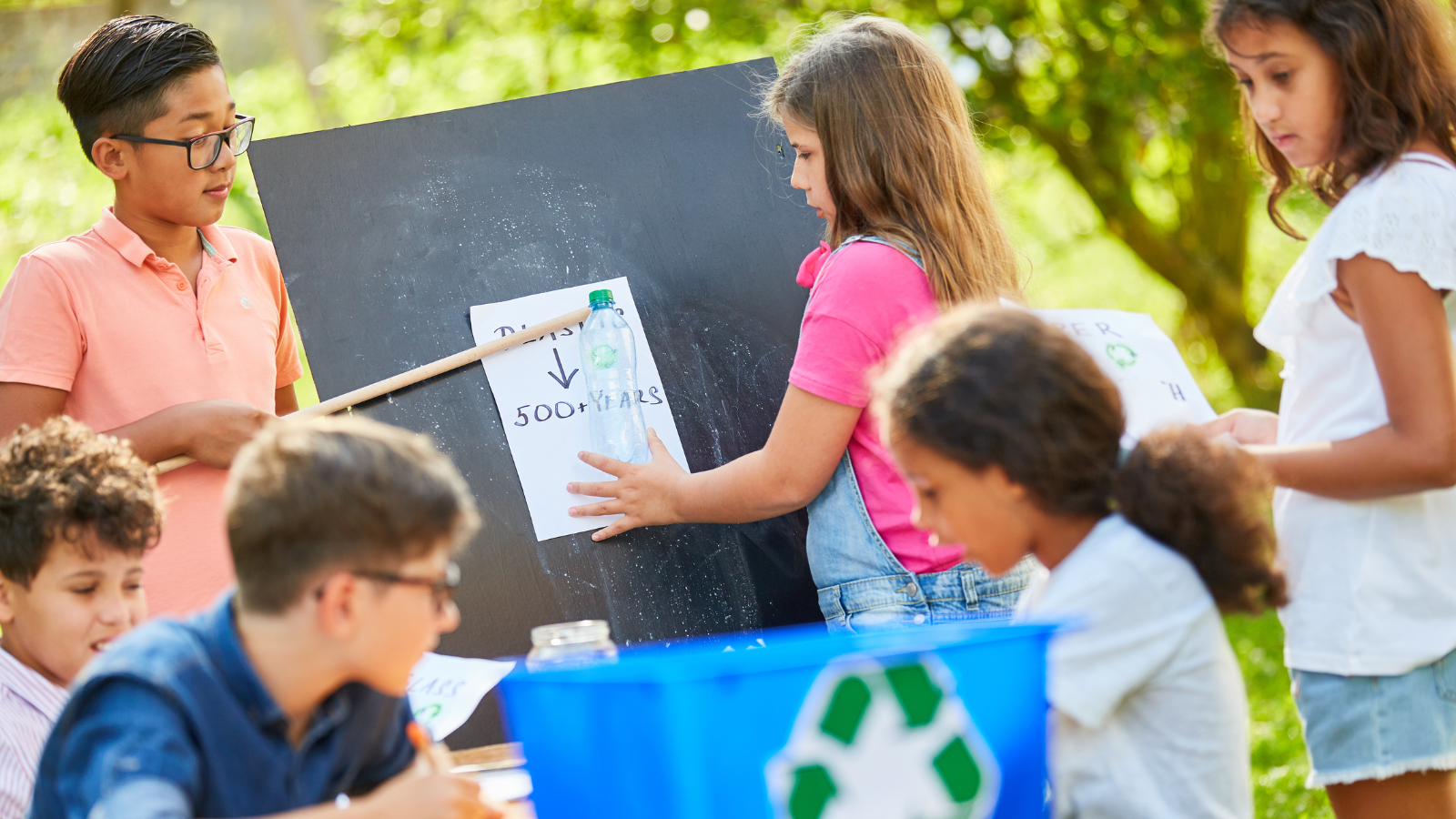Educators Blog
4 Student Engagement Boosters for the Fall!
By Rachelle Dené Poth,
Maintaining student engagement throughout the school year can be a challenge. Learn how integrating hands-on learning activities such as STEM, project-based learning (PBL), outdoor activities, gamification, and more helps maintain student engagement and develop essential skills like creativity, problem-solving, and collaboration.
Now that most schools have been in session for a few months, educators like myself might be looking for new ideas to explore. Some may already be seeing a decrease in student engagement. While the start of a new school year brings great excitement, that can wear off as activities pick up, colder months set in, and the content becomes more complex. Keeping all students engaged in authentic and meaningful learning experiences becomes even more critical during this time and throughout the year.
Along with engaging students more in learning, It's important that we find ways to foster essential skills, such as creativity, collaboration, problem-solving, and critical thinking while making lessons authentic and relevant. In my experience, I have advocated for bringing STEM to all classrooms. Other ideas besides STEM activities include involving students in more active and even outdoor learning, challenge, or project-based learning (PBL) opportunities and using some out-of-the-box ideas. Each of these methods is versatile, and when combined with tools like Defined resources, they help to boost student engagement, spark curiosity, and, best, students retain their content knowledge even more.
Essential Skills Development
As we see so many changes happening in education, especially with technology like AI and other digital tools, students need to develop essential skills that will prepare them for the in-demand careers of the future. According to the World Economic Forum Job Sills Outlook for 2027, these skills include creativity, critical thinking, problem-solving, and collaboration, and now, number three is AI and big data. STEM-related activities provide all students with an excellent way to build these skills. Whether done through coding lessons, hands-on projects, or exploring scientific concepts, STEM encourages students to think critically and solve real-world problems and hopefully spark an interest they may not have realized they had.
Another boost for engagement is when students are more active learners. When we shift them from consumers to creators and innovators, it naturally helps them to build some of these skills. STEM learning can do this! It can be combined with outdoor activities to make learning more dynamic and hands-on. By taking students out of the traditional classroom setting and into nature and the community, for example, we can create opportunities for them to apply STEM concepts in practical and engaging ways. For example, students could conduct experiments on environmental science, collect data, and analyze it using technology, all while spending time outdoors. They can learn more about the world around them. Building the classroom-to-community connection is key!
Using tools like Defined, educators can access a wealth of resources that combine STEM with real-world learning experiences. Defined provides project-based learning (PBL) tasks that align with curriculum standards and help students develop essential skills. With its cross-curricular approach, Defined encourages students to think beyond the boundaries of specific content areas, making learning more meaningful and applicable to real life.
Exploring Outdoor Learning Activities
Outdoor learning is a great way to engage students physically and mentally. As the fall season brings cooler temperatures, it’s the perfect time to take learning outside. Outdoor activities provide students with hands-on learning experiences that foster curiosity, observation skills, and a deeper connection to the content. Even with place-based learning, students connect more with the community and can identify real-world issues. When combined with STEM, outdoor learning becomes a powerful way to encourage problem-solving and critical thinking.
For example, take students on a nature walk to collect samples for a biology project, use simple tools to measure wind speed and direction, or engage them in a design challenge that involves building a structure from natural materials. These activities encourage students to apply classroom knowledge in real-world settings, enhancing their understanding of the content and engagement in the learning process.
Students can use what they see in their community and nature to write a story, to launch a campaign for a need they identify, and so much more. They can even leverage the power of generative AI to design solutions.
Outdoor learning activities help promote collaboration and building relationships that foster a thriving learning community. Students can work in groups to tackle challenges, solve problems, and present their findings to their peers. The collaborative aspect of this work is essential in developing teamwork and communication skills, two of the most in-demand skills for future workplace success.
Integrating STEM in All Content Areas
STEM isn't just for science and math classrooms; it can be integrated into all content areas. For example, in language arts, students could create digital stories using STEM concepts like coding or robotics. We use robots in my STEAM course, and students can choose to program a robot to act out scenes from a novel or build a virtual world that reflects the themes and settings of a literary work. I love using CoSpaces Edu for this! Students are immersed in augmented and virtual worlds and experience learning at different levels. It also has categories that are specific to STEM as well as other content areas, enabling them to become designers. They engage more in learning and retain the content better.
Even for content areas that don’t necessarily fit into the STEM categories, STEM integration is valuable in social studies courses. Students can carry out research focused on historical innovations and then implement engineering principles to recreate inventions or design solutions to identified historical problems. For example, they could design a bridge using the principles of civil engineering to understand the challenges that many ancient civilizations may have faced. How would they design something differently and improve upon it? By combining STEM with other content areas, students see how these concepts are interconnected and relevant to the real world.
Project-Based Learning (PBL) and Student-Led Projects
What a difference PBL has made in my Spanish language and STEAM classes. PBL is one of the most effective ways to boost student engagement, as it empowers students to take ownership of their learning. While it can be challenging for some students to get started when they have so many choices, we just need to offer some guidance and structure. Diving into fully independently guided research and exploration can be tough sometimes, but it has many benefits!
When students are allowed to explore topics of interest and work on real-world problems, they become more invested in their learning. PBL encourages collaboration, as students may work in teams to complete their projects. Initially, my students worked individually and then found commonalities in working together to solve a global challenge, and the learning continued to evolve and transform my classroom.
The possibilities are endless! Students could opt to take on the role of environmental engineers tasked with designing a solution to a local or global environmental issue. Think about the United Nations SDGs. Students first need to research the problem, brainstorm their potential solutions, create prototypes, evaluate and iterate, and then share their findings with the class or, hopefully, with a school community panel. A project like this not only engages students but also fosters a sense of responsibility and purpose as they work to solve real-world problems and brings more meaning to their work!
Gamifying Learning
Incorporating elements of game-based learning is another way to increase student engagement. Gamification provides students with opportunities to learn in a fun and interactive way, which leads to higher motivation and better retention of the content. It also helps with fostering a supportive learning space. My students and I really enjoy options like Blooket, Gimkit, Kahoot!, Quizizz, Quizlet Live, and WordWall. Each has great features and modes of play that truly engage students and keep them actively learning and tracking their personal growth. Beyond the games, gamified learning is particularly effective with STEM activities. For example, students can engage in coding challenges, engineering tasks, or problem-solving competitions. I had a lot of fun doing the solo cup and other hands-on challenges, and they have the same impact on students. A boost in engagement!
Where to Begin?
The key to maintaining student engagement lies in offering diverse learning opportunities, providing choices that allow students to take ownership of their education, and connecting content to real-world experiences. With these strategies, educators can foster a classroom environment that promotes curiosity, creativity, and a love for learning, setting the stage for success throughout the school year and beyond.
With Defined’s resources, educators can access many PBL tasks that align with curriculum standards and promote critical thinking, problem-solving, and creativity. These tasks simulate real-world challenges and help students develop a deeper understanding of the content while building essential life skills.
About the Author:
Dr. Rachelle Dené Poth is a World Language and STEAM Educator at Riverview High School in Oakmont, PA. She is also an Attorney, Edtech Consultant, Speaker, and the author of nine books about education and edtech. Follow her on Twitter/X, Instagram, and connect on LinkedIn. Contact Rachelle for professional learning training and keynotes.
Subscribe to the #1 PBL Blog!
Receive new articles in the world of Project Based Learning, STEM/STEAM, and College & Career Readiness.

